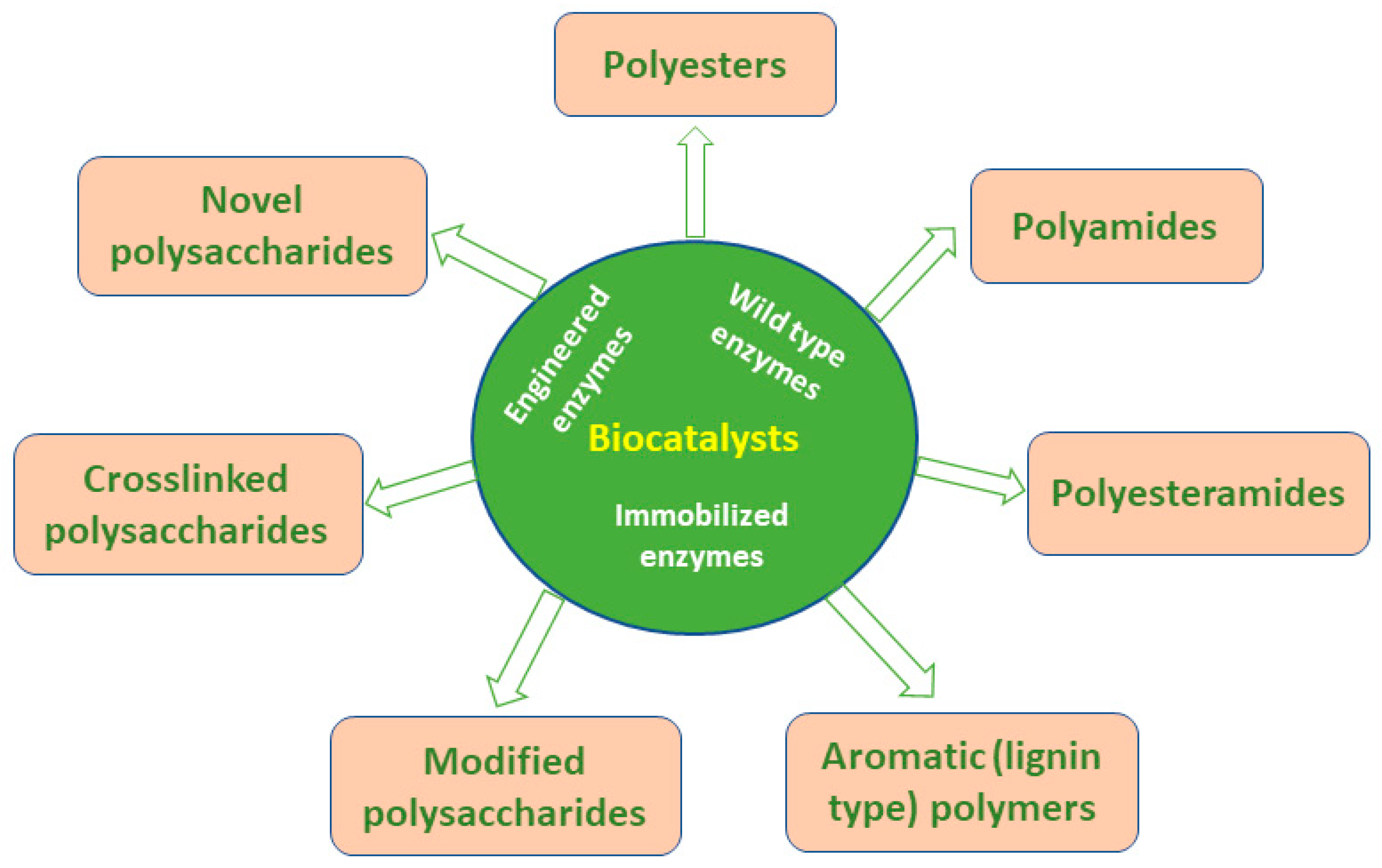Remarkable developments have been achieved in recent decades in terms of the utilization of isolated enzymes as green alternative catalysts in polymer science. Alongside the well-known biopolymers synthesized by microorganisms, such as polysaccharides, polyhydroxyalkanoates, and cutin, among others, an increasing number of bio-based polymers have been obtained in processes catalyzed by native or immobilized enzymes. In particular, the conversion of renewable monomers in environmentally benign polymeric materials, such as polyesters, polyamides, and polyesteramides has become an emerging topic [
1,
2]. The exceptional catalytic power and selectivity of enzymes lead to tremendous possibilities when it comes to carrying out polymerization reactions in vitro (
Figure 1). The utilization of cell-free enzymes, not only as catalysts for polymerization, but also for the preparation of monomers for polymerization or oligomers for block copolymerization, has been consistently developed in recent years [
3].
This Special Issue, entitled “Enzymatic Synthesis and Characterization of Polymers” addresses some of the actual developments in the field of the biocatalytic in vitro synthesis of new polymeric and oligomeric compounds. Special interest has been given to the utilization of bio-based raw materials (sugars, carboxylic acids, hydroxy fatty acids), or the valorization of natural polymers by enzyme-catalyzed modification and functionalization. The employed biocatalysts included native and immobilized enzymes, carrying out the reactions in solventless conditions or different reaction media, the fine tuning of the enzyme specificity, and using advanced methods of process monitoring and product characterization, such as GPC, LC-MS, FT-IR, WAXS, MALDI-TOF MS, and NMR.
The main achievements and the actual trends in the topic of the biocatalytic synthesis of new polyesters and polyesteramides, aimed towards the criteria of sustainability, biocompatibility, and eco-friendliness, were reviewed by Todea et al. [
4]. Although there still exist several bottlenecks in the pursuit of the large-scale industrial implementation of such processes, the green synthesis of specialty polymers using cell-free enzymes is considered a valuable alternative for the chemical catalysis of products with molecular weights not exceeding 10,000 Da, which are interesting for their various biomedical and cosmetic applications. Among the products of interest, copolymers of ε-caprolactone, polyesters with itaconate or furan units, estolides of hydroxy fatty acids, and polyesteramides could represent the main targets for the development of processes using lipases, mostly in immobilized form.
Lipase-catalyzed polycondensation and ring-opening polymerization reactions represent one of the main topics discussed in this Special Issue.
Pospiech et al. [
5] used
Candida antarctica lipase B (CALB, Novozyme 435) for the melt polycondensation of activated dicarboxylic acids (divinyladipate and dimethylsuccinate) with 1,4-butanediol. Carrying out the reaction in melt conditions enhances the sustainability of the process compared with the organic solvent media, even if diffusion control could be a limiting factor. Average molecular weights (assayed by size-exclusion chromatography) of approximately 31,000 g/mol for poly(butylene adipate) and 23,400 g/mol for poly(butylene succinate) were obtained in melt conditions, also reducing the reaction time to 3–4 h when vacuum was applied.
The same CALB lipase (available in immobilized form as Novozyme 435 or GF-CALB-IM) was efficient for the biocatalytic synthesis of new oligoesters of D,L- and D-malic acids and ε-caprolactone, as reported by Dreavă et al. [
6]. The solventless reaction system proved again to have the best performance, and the operational stability of both investigated biocatalysts was excellent during more than 10 batch reaction cycles. The average molecular weights (assayed by MALDI-TOF MS) did not exceed 1500 Da, but the presence of pendant OH groups in the molecule can provide additional functional properties.
Buzatu et al. [
7] investigated a novel chemoenzymatic route for aromatic esters of mono- and oligosaccharides, starting from mono- and diacetals of glucose, sucrose, and inulin, further esterified by 3,(4-hydroxyphenyl)propanoic acid using Novozyme 435 as a biocatalyst in different reaction media, preferably
tert-butanol. Particularly, the aromatic mono- and diesters of inulin monoacetal (with a degree of polymerization of two and three, respectively) could represent the starting point for new sugar ester surfactants.
Kadokawa et al. [
8] used the thermostable α-glucan phosphorylase from
Aquifex aeolicus VF5 for the copolymerization of 2-deoxy-α-D-glucose-1-phosphate, produced in situ from D-glucal, with α-D-glucose-1-phosphate, to obtain partially 2-deoxygenated amyloses. These new non-natural heteropolysaccharides, which are able to embrace different crystalline structures depending on the deoxyglucose/glucose unit ratios, can be applied as biocompatible and environmentally benign functional materials.
Another emergent topic in the field of enzyme-catalyzed polymerization reactions is the cross-linking of natural polymers, e.g., polysaccharides, to improve the texture and firmness of plant-based gels, as demonstrated by two important contributions authored by Khalighi, Berger, and Ersoy [
9,
10]. In the first study [
9], arabinoxylans from wheat bran were oxidized using commercial and self-produced laccases, yielding a covalently cross-linked network with a solid and stable texture, comparable in firmness to the traditional gelatin gels. These arabinoxylan gels retained their viscoelastic properties during a storage period of up to six weeks at 25 °C and can be classified as vegan. The second work from the same authors [
10] addressed the cross-linking of sugar beet fiber (fibrex) pectins, using a self-produced laccase from
Funalia trogii. Again, a crosslinked and hard edible gel was produced, with viscoelastic gel characteristics including heat resistance, a high swelling ratio, and a high water-holding capacity. Such gels could have important applications in the pharmaceutical and food industry.
The editors are confident that this Special Issue demonstrates the actual development of the biocatalytic synthesis of polymers as a versatile tool for the next generation of bio-based and biodegradable oligomers and polymers. We acknowledge the authors for their contributions, the reviewers for improving the scientific soundness of the manuscripts, and the staff of the editorial office of Processes, particularly Assistant Editor Tami Hu, for their consistent and valuable support.






